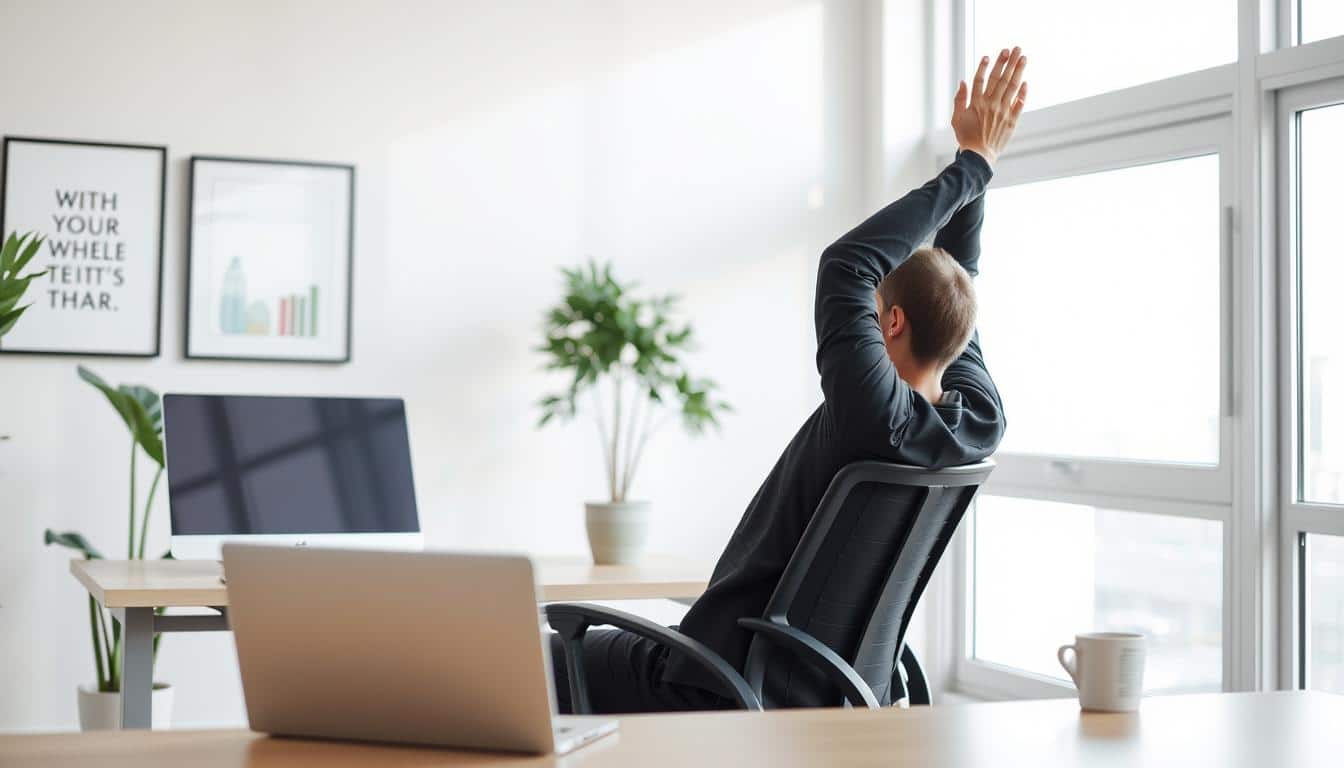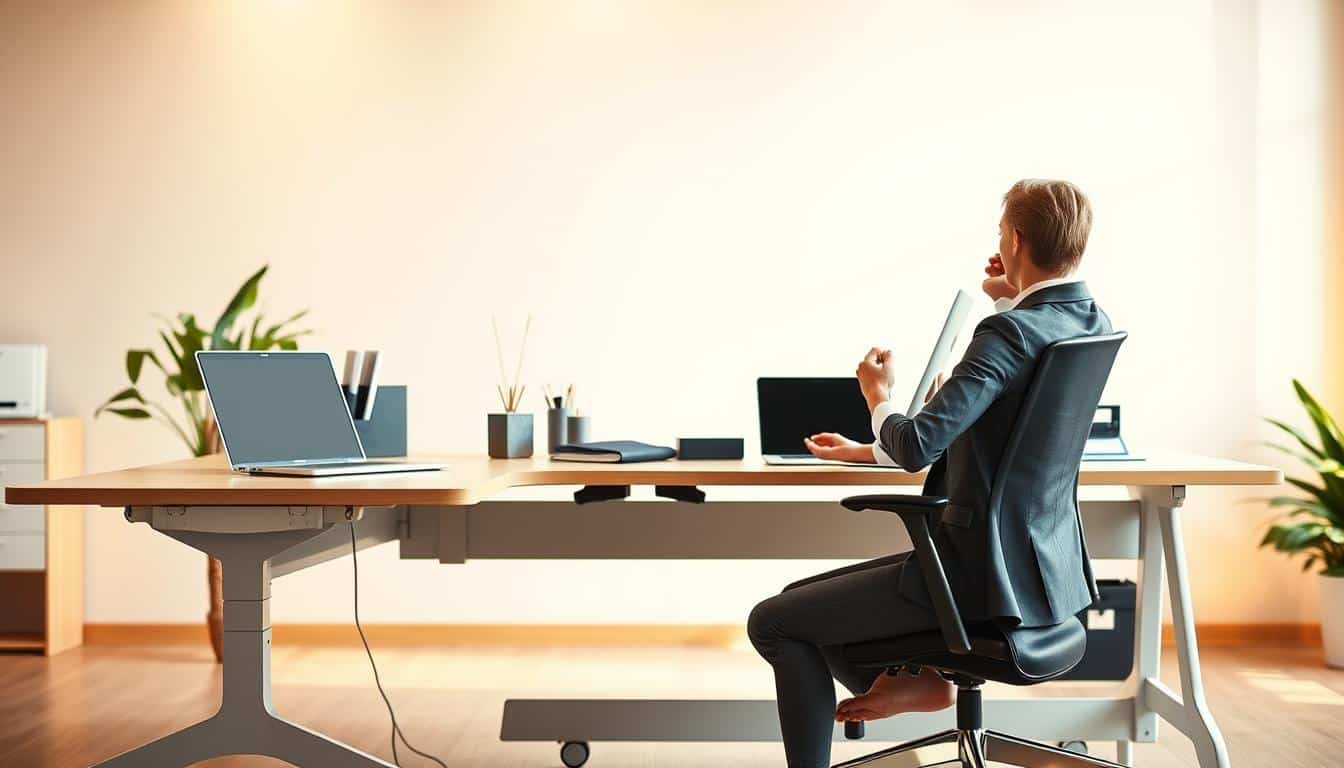Seated yoga is an easy type of yoga that you do sitting down or with the help of a chair. It’s great for everyone, especially if you’re just starting, are older, or have some physical limits. It helps make your body more flexible, focusing on the sides, back, legs, and hips.
Every pose in seated yoga can be changed to fit how strong or flexible you are. This makes it a gentle way to help your blood flow better and feel less stressed. Seated yoga is safe and easy to do because it teaches you the right way to move. Doing it often can make you move more easily, get stronger, know your body better, and lower stress.
Introduction to Seated Yoga
Seated yoga is a gentle type of yoga made for those who find regular yoga hard. It’s done sitting in a chair, which makes it very safe. It’s great for people with health issues, older adults, or those with disabilities, often suggested by doctors to help their patients.
Seated yoga helps improve both your body and mind. When you do seated yoga, you could see many benefits like:
- Improved muscle tone
- Better breathing habits
- Stress reduction
- Better sleep
- Enhanced mood
In a seated yoga class, people do breathing exercises, get warmed up, and try out poses that are changed to be easier. The class ends with meditation or a time to relax. This helps participants become more in tune with their body and mind. When doing seated yoga, it’s important to sit in the middle or front of the chair and keep your feet flat on the ground.
Seated yoga makes changes to regular yoga poses to meet different needs and abilities. This way, everyone can get into wellness, no matter what.
Benefits of Seated Yoga for Flexibility and Health
Seated yoga boosts health, especially in flexibility and wellness. It makes muscles stronger and helps you move better. This is important for keeping balance and avoiding falls, especially for older people. Studies show chair yoga is good for people with knee problems.
It’s also great for reducing stress. A study in Evidence-Based Complementary and Alternative Medicine found 15 minutes of chair yoga can lower stress. It improves focus, lifts your mood, and makes you feel calm. So, it’s perfect for dealing with anxiety or depression.
It helps a lot with pain management. Seated yoga reduces chronic pain and inflammation and helps blood flow and sleep quality. Moves like seated cat cow and chair pigeon prevent injuries and improve mobility.
Seated yoga is good for people of all ages. It helps increase self-awareness and emotional health. With mindful movement, it’s a great way to become more flexible and resilient in life.
Who Can Practice Seated Yoga?
Seated yoga is open to everyone, and it’s especially great for a wide variety of people. It’s a fantastic choice for seated yoga for seniors, as it helps them stay flexible and strong without much strain. It’s also perfect for people with limited mobility, including those healing from injuries or dealing with chronic pain. This yoga style is gentle enough for beginners and those who have been practicing for a while.
For those new to yoga, seated yoga is a welcoming starting point. It’s perfect for individuals facing challenges like obesity, pregnancy, or injuries. It also accommodates those in wheelchairs, recovering from surgery, or having trouble with balance. This makes seated yoga a versatile option for many.
Seated yoga can be done in different places, like at home or in the office. This makes it a great choice for people who are busy, like workers or students. Using things like blocks and straps can make it even better by providing extra support. Seated yoga is a supportive way for almost anyone to boost their health through more activity.
Essential Preparations for Seated Yoga
Choose a strong chair without wheels or armrests for seated yoga. It should support you well during practice. Ensuring your feet touch the ground comfortably is key.
Using props like blocks or blankets can make a big difference. They raise your hips and help with alignment in seated poses. For deeper stretches, props under your hands or legs are great.
Modifying poses can make them easier on your body. Adjusting leg width or bending knees can help keep your spine straight. Use support under your hips or legs in certain poses for comfort.
Before starting, make sure the area around your chair is clear of anything you could trip over. Wear clothes that won’t restrict your movement. Always begin with a gentle warm-up, focusing on breathing.
When doing seated yoga, move slowly and make pose adjustments as needed. It’s always smart to talk to a doctor before starting new exercises, especially if you have health issues.
Seated Yoga: Gentle Poses Overview
Seated yoga features easy postures meant to improve flexibility and health. These poses are great for those new to yoga as they don’t require much mobility or strength. They’re a great way to start exploring what seated yoga has to offer.
Seated Side Bend (Parsva Sukhasana)
This pose focuses on side stretching to help your spine and rib muscles. Start by sitting cross-legged. As you breathe in, lift one arm up and lean to the side. This creates a deep stretch along your side, making your spine more flexible.
Seated Spinal Twist (Parivrtta Sukhasana)
The seated spinal twist is great for making your spine more flexible and aiding digestion. Sit with your legs crossed and place one hand on your knee and the other behind you. With each breath in, make your spine taller; as you breathe out, twist gently. This move helps relieve tension and refreshes your body.
Head to Knee Forward Bend Pose (Janu Sirsasana)
This pose focuses on stretching your hamstrings and lower back. It also calms your nerves. Sit with one leg out and the other foot against your thigh. Lean forward over your extended leg as you breathe out, keeping your spine long. This helps with deep stretching and relaxation.
Bound Angle Pose or Butterfly (Baddha Konasana)
This pose works well for opening up your hips and increasing flexibility there. Sit down, press the soles of your feet together, and let your knees drop to the sides. You can lean forward a bit for a deeper stretch. It’s a gentle way to boost circulation and flexibility around your hips.
Incorporating Breath and Mindfulness in Seated Yoga
In seated yoga, combining breath and mindfulness is very important. Deep breathing helps us relax and think more clearly. By paying attention to our breathing, we learn more about ourselves and feel refreshed.
Mindfulness can easily fit into moving exercises. Doing mindful activities, like stretching while sitting, helps us notice our body and surroundings. This is great for kids and teens. It helps them be curious and mindful in a fun way.
Here are three mindful movement practices that can enhance your seated yoga routine:
- Blossoming Flower Arms: Synchronize arm movements with your breath, focusing on energizing your fingers. Reflect on how this makes you feel.
- Full Arm Circles: Perform circular arm movements while noting your comfort in the direction of motion. This practice promotes body awareness.
- Moving Forward Folds: Combine gentle spinal flexion with breath, encouraging reflection on different sensations throughout your body during the pose.
For seniors, gentle exercises and breath awareness help connect with their bodies. Techniques like guided visualization and body scans enhance focus on the present. Regular mindfulness helps lessen stress and anxiety. It also supports emotional health and improves memory and focus.
How Seated Yoga Enhances Mental Well-being
Seated yoga helps our mental health by creating a peaceful space. It makes us relax and think deeply. When we use seated yoga to fight stress, it soothes our nerves. This helps lower anxiety and makes us feel happier. It’s perfect for those looking for calm in their busy lives.
Stress Reduction and Relaxation Through Seated Yoga
Doing seated yoga regularly helps manage stress well. Its soft movements and focused breathing make our minds quiet. Research shows yoga makes sleep better and boosts mental health. By keeping up with it, people may find:
- Increased relaxation and less anxiety.
- Better energy and focus.
- A stronger sense of togetherness with fellow yogis.
Improving Focus and Clarity with Mindful Breathing
Mindfulness in yoga sharpens our concentration and clears our mind. Through breathing and chanting, we connect deeply with ourselves. This brings peace. Stick with it and you could see:
- Better insight into your thoughts and feelings.
- Stronger defense against daily stress.
- Boosted performance at work or in life.
What You Need for a Successful Seated Yoga Practice
For a great seated yoga time, picking the right yoga gear matters a lot. A solid chair without armrests, like one from your dining room, is perfect. Keeping your thighs level with the floor ensures balance and control. If your knees aren’t lined up right, try a folded blanket under them.
A folding chair is super useful for its flexibility. But, any firm chair with four legs will do. Putting the chair on a yoga mat stops it from sliding. This helps balance and makes poses like Warrior 3 or backbends safer.
Using a chair can make meditation easier for those who struggle with sitting on the floor. Seated yoga boosts balance and helps you focus better. It makes you feel more stable during poses with grounding methods.
You can do poses like wide supported squats and chair pose while sitting. These practices are made to fit anyone just starting with yoga. It makes sure everyone can join in and enjoy seated yoga.
Creating the Ideal Environment for Seated Yoga
Creating a peaceful yoga space is key for better seated yoga. It helps you focus and relax, which you need for a good session. Look for a quiet spot that’s free of clutter and feels welcoming.

Soft lighting is important to set the mood. Use dim lights or candles for a calm effect. Make sure the room is a nice temperature to stay relaxed. Adding elements like essential oils, soft music, or calming pictures can also make a big difference.
Supportive props, like bolsters or blocks, improve your yoga. A sturdy, non-rolling chair helps with alignment and stability in poses. Putting your chair on a mat stops slipping and keeps you safe.
- Adjust props like bolsters or blocks under the hips or feet for added comfort and support.
- Modify poses by adding or removing props as needed to ensure accessibility.
- Use the chair for support to make the practice more inclusive for individuals with limited mobility.
- Focus on proper alignment and breathing techniques with the chair as a grounding tool.
Adding these elements makes your yoga environment and practice better. It helps everyone, no matter their age or ability, to enjoy yoga. It’s all about being mindful and relaxed.
Conclusion
This recap shows the many benefits of gentle seated yoga. It helps improve health and flexibility for all ages and abilities. The positive changes in grip and muscle strength, along with better balance, show how important it is.
Seated yoga is great for both the body and mind. It reduces stress and brings people together. We should all try to do seated yoga regularly to better our lives.
Starting seated yoga regularly can lead to a healthier life. Freedom Home Care supports this whole approach. It’s all about gaining flexibility, strength, and friends along the way. This can really make our wellness journey complete.



